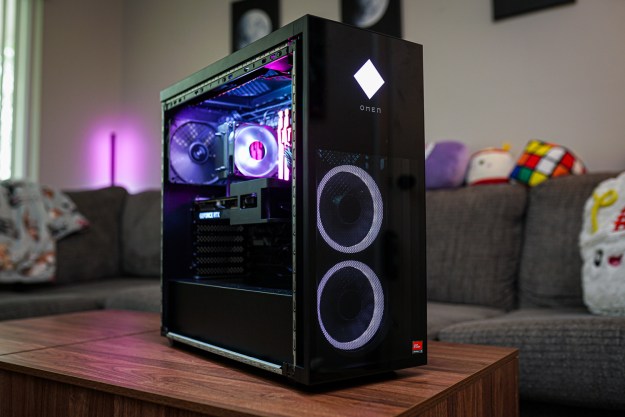 Those wacky kids at DARPA are at it again. The Pentagon’s official mad scientist division has created a new set of eyes for soldiers in the battlefield, that could soon become standard issue for all soldiers in combat. The Soldier Centric Imaging via Computational Cameras system, also known by the only slightly less cumbersome acronym SCENICC, is a new helmet with and eyepiece that is under development, and would radically alter the way soldiers saw the battlefield.
Those wacky kids at DARPA are at it again. The Pentagon’s official mad scientist division has created a new set of eyes for soldiers in the battlefield, that could soon become standard issue for all soldiers in combat. The Soldier Centric Imaging via Computational Cameras system, also known by the only slightly less cumbersome acronym SCENICC, is a new helmet with and eyepiece that is under development, and would radically alter the way soldiers saw the battlefield.
Finding ways for soldiers to remain linked together and to both share and receive updated maps in real time, has become one of the military’s primary goals for new technology development (well, that and really, really powerful guns, of course). Everything from smartphones to tablets have been suggested for field use, and studies are underway on several different ways to convey this information. Looking to take your iPhone into the field of combat and track enemy troop movements? There’s an app for that. Or there soon might be, but SCENICC is something a little more complex that won’t require you to take your eye off the field.
According to Wired, who were brave enough to read the DARPA release and in doing so were subjected to an example of the most fiendish weapon a government has at its disposal— bureaucratic paperwork— SCENICC is ready to begin development and just needs the approval and funding of the Pentagon.
If approved, SCENICC would deliver augmented reality to soldiers in the field, and for lack of a better description, make everything look like a bit like a video game. Although some of the technical details were a little unclear in the DARPA report, the system will be networked to allow real time information on mission objectives and terrain that will be sent directly to the soldier’s eyepiece. If a friendly soldier moves into the line of sight, the system will recognize the soldier and display the words friendly, or show an icon that would convey the same thing. If a muzzle flash was recognized, a display would point to the direction, and it would even be combined with targeting on the soldier’s weapon to make for more accurate fire.
SCENICC would also be able to receive basic commands and display them for the soldier. If a new objective is issued, the display would flash a brief text message and tell the soldier the new information needed. If it included a new location for the soldier to move to, the display would highlight that location and point out the direction. It could also conceivably show soldiers where enemy combatants might be hiding, which means that SCENICC would conceivably also be to receive up-to-date information from some form of overhead spy plane or satellite, which would allow real time positioning.
The system would also come equipped with tiny cameras all around the helmet to offer a 360 degree view of the field, as well as a telescopic function to increase the zoom by up to 10 times. All of the commands would be voice activated to allow the soldiers to keep their hands free.
DARPA is not the only group currently in development on a system that would display information to soldiers through an eyepiece, but they are the furthest along, and the SCENICC is by far the most advanced of the systems that have been unveiled.
Raytheon, Rockwell Collins and General Dynamics are all currently under contract with the military to design a wearable platform for digital maps, computers and radios that can network with each other and be displayed into helmet mounted eyepieces. The first project the companies were involved with was called Land Warrior, but after years spent in development, it was deemed a failure due to the weight and bulk. A second project was then commissioned.
The first requirement of the new project, Nett Warrior, is that the system must weigh under 8 pounds, while still retaining the features established in the Land Warrior program. The Pentagon will view the official proposals in March, and determine which of the three companies, if any, will receive the approval to continue to development.
DARPA is an interesting group, and while not developing flying cars, taunting civilian car manufacturers, building military AI that could kill us all, and lots of other stuff that–honestly– we will probably sleep better at night not knowing about, the research wing is hard at work making things that will improve the battle conditions for soldiers, and make American troops safer. The group also tends to be further ahead than most of its competitors in terms of new technology, and SCENICC is another example of that. By the time any of the Nett Warrior projects make it into testing—several years from now at least–SCENICC will most likely have reached the full scale production stage and DARPA will have already begun work on its replacement. And while the Nett Warrior system is struggling to stay under 8 pounds, SCENICC—which offers several features that the Nett Warriors projects don’t require—weighs less than a pound and a half.
Much of the science behind SCENICC is vague at best, either because of the classified nature of DARPA’s work, or because the research group is still working out how to fulfill some of potential of the device, especially in conditions that make it difficult to receive incoming information—areas like remote sections of Afghanistan, for example. But if it is approved, the first round of testing could begin within two to three years, with the first production models reaching soldiers in the field, within four years.


